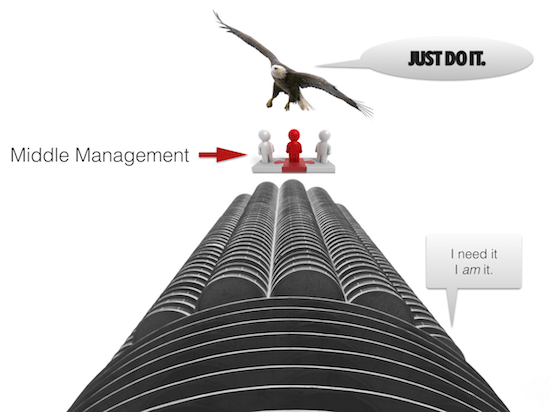When trying to drive digital transformation into your organization, have you ever noticed how most initiatives just seem to dissipate? It’s like when a stone thrown into a lake, where the sploosh and ensuing ripples just return to a placid surface. The same goes for innovation. Organizations sometimes like to combine digital transformation with innovation. Surely, digital tools and platforms overlap, but there are specificities to each. Even if innovation and digital transformation are not the same thing, innovation is more than just digital, but digital touches everything. {Please tweet ♺!} And both — digital transformation and innovation — are more about mindset than technology or the final product per se.
What’s stopping us?
To the extent innovation is a fundamental key to growth, there are few executives — notably in big business — who don’t wish to stimulate more innovation and entrepreneurial spirit. Putting a digital transformation program to the service of innovation is a sensible approach. Yet, even in this case, digital transformation and innovation “drives” both have a tendency to get stuck in the mud. It strikes me that there are three main reasons why innovation does not “take hold” as desired.
- The overriding purpose of the company — in whose service innovation is designed to propel the company forward — is either unclear or unknown.
- The organization has not clearly defined or expressed the overall strategy. Sometimes, this is a question of definition; but it can also be a question of communication. And, emphatically, this strategic vision must help to parse out and eliminate the activities and legacy habits that are not relevant or plainly unnecessary.
- The boss does not model the behavior requested or required. In particular, the boss (as well as his/her cohorts) must show personal engagement and effort, and — perhaps most importantly — the emotional inspiration.
Time is not on my side
As a direct consequence of the above, there is a dramatic over-sollicitation of the most rare asset: time. The most common refrain that I hear in organizations is the lack of time.
Do that new project? Are you kidding! I just don’t have enough time in the day as it is.”
Systematically, managers are complaining that there is not enough time to “add” innovation onto the list of daily routines. Some approach this by trying to be more productive, i.e. to make meetings more efficient or cut down on emails, etc. Others just work longer hours. The real issue is that the middle manager ranks — where execution happens — get completely bogged down. {♺!} A common refrain is that transformation in an organization must be top-down and bottom up. The logical conclusion is that the middle managers are, well, stuck in the middle.
Top down?
The C-suite will come back from a meeting with consultants or an off-site pow-wow and will be all excited to “kickstart” some new digital programs as part of the innovation thrust. Intellectually, the senior managers understand that there is a need to take action. However slow they might initially have been to grasp the importance of the digital revolution, they are all now fully on board with the strategic nature of the challenge, no matter the industry. To take one example among many, Nicolas Cordier, CEO of the beauty brand, Make Up For Ever, attests:
Digital is strategic for a professional makeup brand like ours…”
Nicolas Cordier (via Blinging Beauty)
As a result, top managers preach from the pulpit and push down orders.
Bottom Up?
Meanwhile, the younger staff, fresh out of school, chomping at the bit and far more in touch with the customer reality (B2B or B2C), are clamoring for more access, more information and, frequently, more autonomy. In lieu of easy access to information and direct contact to the resident experts within the company, the “feet on the street” are, too often, thwarted and frustrated for the layers of hierarchy, the lethargic communication and laborious decision-making.{♺!} The younger staff are demanding the digital tools and networks from the middle managers.
The middle managers are, thus, stuck in the middle, not necessarily for a lack of trying or incompetency. They are compressed by a top-tier team that has, more often than not, failed to provide a clear vision. In parallel, top management has ignored the need to unlearn old practices and unclutter the agenda in order to free up the necessary resources (especially: time) to enable the middle managers to execute. Digital transformation is not an overnight program. It is a long-term process that involves changing mindsets and adjusting behaviors.{♺!} It means being clear about how digital can fit into the strategy. And, to the extent the brand or company can determine a higher purpose (beyond just satisfying shareholders), digital transformation that serves a unifying cause helps foster genuine employee engagement.{♺!}
Your thoughts and reactions?











